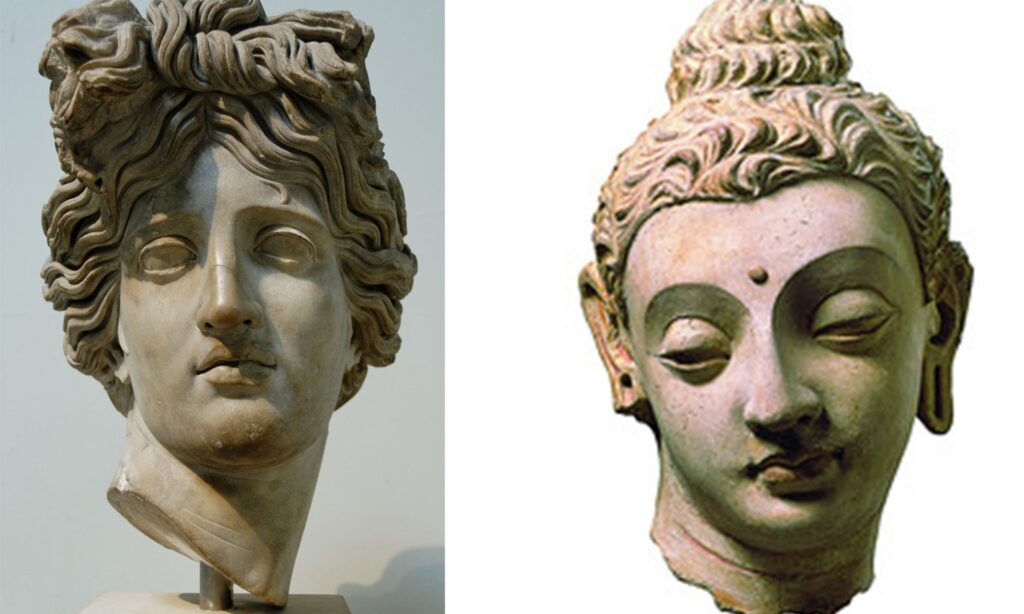We have all seen sculptures of the Buddha like this one. Beautiful soft features. Meditative trance-like state. Benevolent stance. Dreamy eyes.
But have you ever stopped to notice the clothes? Have you paused to wonder why he drapes a Greek or Roman-senator-like toga over his shoulders?
Well…stop and take a look now, if you haven’t done so before. For it is a little window to step back into time and discover a fascinating slice of our past.
Greek connections
To unravel the connection between the Buddha and his Greek-toga, we need to travel to the north west frontier of the subcontinent. To the Hindu Kush region.
The rugged mountain slopes of this region have been at the cross roads of exchanges between various cultures for centuries. Peshawar, the biggest city of the region in fact gets it very name from this background – Pesh awar means frontier town – for it is the veritable doorway into the Indian subcontinent from the highlands of Afghanistan.
It was the frontier not just for the goods that travelled along the Silk Route in the early years of this millenia but also for other exchanges – cultural, linguistic, military and more.
In 327 BC, Alexander led his Macedonian army into this region, intending to conquer the world, or atleat the world as he knew it to be back then. The story goes that when his tired and weary soldiers protested, Alexander was forced to give up his campaign after crossing the Jhelum and forced to return.
However, he left his garrisons and men along the route to command and rule in his name. Soon thereafter, Alexander died, allegedly poisoned when he was in Babylon, and his vast empire crumbled.
The Greek commanders he had posted along the way to take care of his territories remained where they had been left, taking control of their own little regions. And that was how Greek influences began to play a greater role in the culture of the region.
This region was called Gandhara – it extended from Punjab to Afghanistan. The character Gandhari in the Mahabharata was called so, because she was the daughter of the King of Gandhara.
Gandhara was a centre where Buddhism flourished as the Kushan kings that ruled the area shortly after Alexander returned, were great patrons of Buddhism. Kanishka in particular, was a devout follower of the Buddha’s teachings.
Human Forms of the Buddha
One of the unique contributions of this region was the depiction of Buddha in human form.
Up until then, it is said that the Buddha was not depicted in human form – but as a symbol. The symbols used were the wheel or a stupa or the lotus and so on. But influenced by Greek art where Greek gods were depicted in human form, the Buddha also began to be depicted in human form. The art of this region came to be known as the Gandhara School of Art.
Situated as it was in the region where the Greeks had settled and along the Silk route where people from various regions criss-crossed, the art of this region imbibed multiple influences and the Buddha was depicted in a manner very similar to the Greek and Roman gods.
“The Gandhara artist had the hand of a Greek but the heart of an Indian.“
Popular quote about Gandhara Art
The meditating Buddha dressed in a Greek toga became a lasting symbol of this region. The posture, the expression, the curly hair, the toga over the Buddha’s shoulder – they were all inspired by Greaco-Roman art and hence the Gandhara School of Art is also known as the Graeco-Roman school.
One also finds here several stupas (apparently there were over 2400 Buddhist shrines in this region) which take the themes for the art work from Buddhist mythology and scripture, but their styles are inspired by classical Greek and Roman art.
William Dalrymple
“The slowly decaying remains of the civilization which emerge from this extraordinary clash of cultures, still litters much of northern Pakistan.”

The Art of India, as also her people – are a complex and fascinating amalgamation of the mixing of various cultures and people. The bedrock of our diversity and strength is indeed the openness of our people to influences of every hue and the willingness to learn, adapt and grow with time.
In a sense, the Buddha in a Greek toga stands for this very essence of India.
